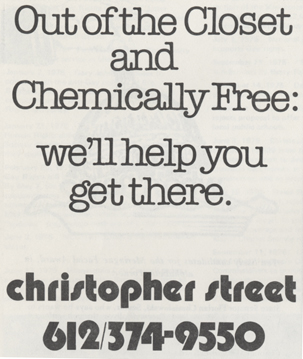Christopher Street (Minneapolis)
| Few can presently imagine the Twin Cities’ queer social scene in 1972. Twin Cities Pride just began with a small gathering of 50 people, and there were only a handful of community service organizations or social groups.
|
 Christopher Street ad from the 1977 Twin Cities Pride Guide, page 7.Courtesy of the Jean-Nickolaus Tretter Collection. |
Alcohol and drug use served as a solace for these populations, who often fell into the trap of alcoholism and drug addiction.
Named for the site of the Stonewall Riots in Manhattan, Christopher Street was another apparent first for the U.S. GLBT community. It offered counseling services for drug and alcohol addiction before Alcoholics Anonymous and Narcotics Anonymous offered gay and lesbian support groups within their organizations. Christopher street organized social event when gay and lesbian bars (or house parties that served liquor) constituted a majority of queer social space before the late 1970s.
| In part, this alcohol-centric social atmosphere was the result of Minneapolis’ strict liquor patrol limits—this law relegated all Minneapolis liquor establishments to three locations: the Sumner-Glenwood area, the Gateway District, and the area surrounding Franklin Avenue and Cedar Avenue.(2) These concentrations spawned simultaneous concentrations of illegal activity such as prostitution, illicit drug use, and homosexual activity. Thus, and for a time, alcohol abuse and homosexual activity were forced to coexist.
|
Christopher Street ad from the 1977 Twin Cities Pride Guide. Courtesy of the Jean-Nickolaus Tretter Collection |
(1)McNaron, Toni A.H. Ed. Zimmerman, Bonnie and Haggerty, George E.. "Alcohol and Substance Abuse" Lesbian Histories and Cultures: an Encyclopedia. New York: Garland Publishing, 2000. Pages 22-23.
(2)Sanford, Edwin Patterson. "The Saloon Within Patrol Limits" The Outlook, vol.77. 1904.
(3)http://www.pride-institute.com/about/
Part of Minneapolis/St. Paul, MN: 100 Queer Places in Minnesota History, (1860-1969), (1969-2010)
